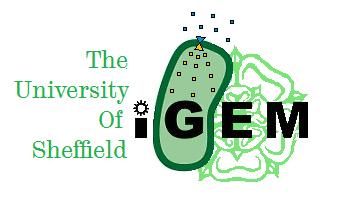Team:University of Sheffield /Project
From 2008.igem.org
m |
|||
| Line 22: | Line 22: | ||
{|align="right" | {|align="right" | ||
| - | |[[Image: | + | |[[Image:Sheffield_igem_logo.JPG|300px]] |
|} | |} | ||
Revision as of 21:02, 16 August 2008
| Home | The Team | The Project | Calendar of Events | Notebook |
|---|

|
Contents |
Overall project
Project Overview
The aim is to engineer a biological machine that will sense microbial contamination of drinking water using quorum sensing. Quorum sensing systems use sensing proteins in the membrane (histidine-kinases in this case) to detect molecules excreted by the bacteria’s own species. After detection in the membrane, a phosphate signal is passed down pathway, causing a DNA regulatory effect. Each species also has its own corresponding quorum-producing protein. In Vibrio cholerae the sensing protein is CqsS and the quorum-producing protein CqsA, and in Legionella they are LqsS and LqsA.
If everything goes well
Our organism would initially sense Vibrio cholerae or Legionella. This will be done by hijacking a pathway already present in E.coli – the non-essential kdp pathway which is partly responsible for K+ detection and response regulation. This pathway has a similar histidine-kinase as its sensing molecule (KdpD) to Vibrio cholerae and Legionella, and results in a strong DNA response. The original KdpD will be knocked out of E.coli to make way for recombinant receptors. The recombinant receptor will be made from the sensing part of the pathogens quorum sensing protein, fused with the signaling part of KdpD. Due to the similarity of the two receptors in certain regions, this should allow quorums to be detected using the pathogens sensing mechanism, but the signal to be passed to the kdp pathway. The target genes at the end of the kdp pathway will be modified so as to express the bioluminescent, luciferase, as an indicator there are quorums (and therefore pathogens)present. Luciferase was chosen due to its ability to be detected without expensive equipment, and the possibility of targeting proteases for its degradation if we chose to make the machine re-useable.
Two recombinant proteins will be produced, one made from CqsS and KdpD, and the other LqsS and KdpD, each destined for different E.coli. Using a high-copy plasmid we should be able to get large-scale production of the recombinant proteins which may lower the threshold number of quorum molecules required to trigger the pathway. The result is two E.coli strains, capable of sensing either Vibrio cholerae or Legionella.
History of development
- Early Brainstorming & Other Crazy Ideas
- A Selected Primary Idea: Sensing Pathogens & Biochip
- v1.0: A completed Design Proposal & Basic Model
- The final proposal: The hybrid-hybrid Sensor
Project Details
| Parts submitted to the Registry |
|---|
| Modelling |
|---|
 "
"